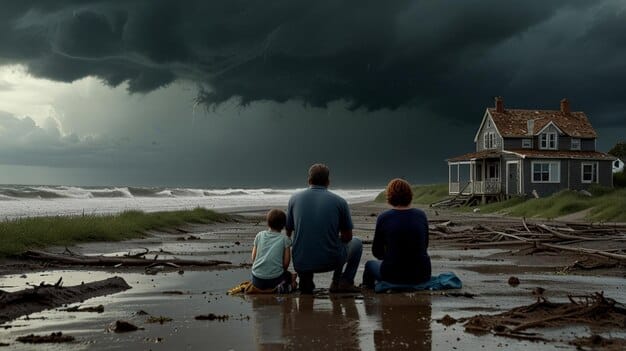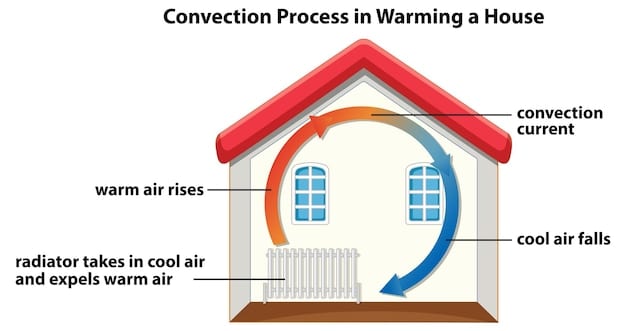Extreme Weather Preparedness: Is Your Home Insurance Adequate for 2025’s Forecasted Storm Surge?

Navigating the complexities of home insurance adequacy against extreme weather, particularly for 2025’s projected storm surge, necessitates understanding policy limitations, considering advanced protective measures, and proactively evaluating potential gaps in coverage to safeguard assets and ensure resilience.
As climate patterns intensify and unpredictable weather events become the new norm, understanding your home insurance coverage is more critical than ever. This is especially true when considering Extreme Weather Preparedness: Is Your Home Insurance Adequate for 2025’s Forecasted Storm Surge? Proactive evaluation can make all the difference between recovery and financial devastation.
The Escalating Threat of Extreme Weather and Storm Surge
The global climate continues to shift, leading to an undeniable increase in both the frequency and intensity of extreme weather events. For many, particularly those inhabiting coastal regions or areas prone to severe storms, the specter of storm surge looms large. This isn’t merely about heavy rainfall; it encompasses the devastating wall of water pushed ashore by hurricanes and tropical storms, capable of inundating homes and infrastructure in moments.
Scientists and meteorological organizations consistently update their projections, and the outlook for 2025 suggests a continued, if not intensified, risk of significant storm surge events. This forecast is not just a statistic; it’s a call to action for homeowners to critically assess their vulnerability and, more importantly, the robustness of their protective financial measures. The historical context of events like Hurricane Katrina or Superstorm Sandy provides stark reminders of the profound and long-lasting impacts of such catastrophes. These events underscore a vital truth: preparedness extends far beyond boarding up windows; it delves deep into the often-overlooked realm of insurance policies.
Understanding Storm Surge Dynamics
Storm surge is distinct from common flooding. While intense rainfall can cause rivers to overflow or urban drainage systems to fail, storm surge results from high winds pushing water onto land, often far exceeding typical flood levels. This phenomenon is amplified by rising sea levels, making coastal areas increasingly susceptible to damage. The destructive power lies not just in the water’s volume but also in its velocity and the debris it carries, which can batter structures and erode foundations.
- Hydrostatic Pressure: The sheer weight of standing water against walls.
- Hydrodynamic Force: The impact of moving water, carrying debris.
- Erosion: Undermining of foundations and surrounding land.
The implications for homeowners are profound. Beyond structural damage, storm surge can lead to extensive mold growth, compromised electrical systems, and contaminated water sources, rendering homes uninhabitable for extended periods. The path to recovery is often arduous and incredibly expensive, making adequate insurance coverage not just a convenience, but a necessity for survival.
Predictive Models and 2025 Forecasts
Advanced predictive models, leveraging satellite imagery, oceanographic data, and historical storm paths, provide increasingly accurate forecasts for future storm seasons. While specific storm tracks remain unpredictable, the general trends for 2025 point towards warmer ocean temperatures, which fuel stronger hurricanes, and atmospheric conditions conducive to their formation and intensification. This means a higher probability of major hurricanes making landfall, bringing with them the heightened risk of significant storm surge along vulnerable coastlines. Homeowners in these zones must heed these warnings as timely opportunities for review and fortification.
The scientific community emphasizes the probabilistic nature of these predictions, encouraging a balanced view that prioritizes preparedness over panic. The data suggests that while not every predicted event will materialize with maximum impact, the cumulative risk factor is undeniably on the rise. Therefore, decisions made today regarding insurance coverage are investments in future resilience.
In summary, the increasing threat of extreme weather, particularly storm surge, demands a proactive and informed approach from homeowners. Understanding the mechanics of storm surge and acknowledging the grim forecasts for 2025 are essential first steps towards safeguarding one’s property and financial well-being. The subsequent discussions will delve into how existing home insurance policies may fall short and what steps can be taken to bridge those gaps.
Decoding Standard Home Insurance vs. Flood Insurance
Many homeowners operate under the misconception that their standard home insurance policy offers comprehensive protection against all forms of water damage. This prevailing belief is often shattered in the aftermath of a devastating storm, particularly when storm surge is involved. A critical distinction needs to be made: standard home insurance policies typically exclude damage caused by flooding, and this exclusion applies directly to storm surge.
Standard home insurance policies are designed to cover a broad spectrum of perils, such as fire, lightning, windstorms (though often with specific deductibles for named storms), hail, theft, and liability. They generally cover internal water damage, such as a burst pipe, or damage from a wind-driven rain if the property’s envelope (roof, walls) is first breached. However, when water comes from the outside, rising from the ground or a body of water, it falls under the purview of flood insurance, a completely separate and often federally backed program.
The Flood Insurance Gap: Why Standalone Policies are Crucial
The National Flood Insurance Program (NFIP), administered by the Federal Emergency Management Agency (FEMA), is the primary source of flood insurance for many homeowners in the United States. While private flood insurance options are growing, NFIP remains a significant player, especially in high-risk flood zones. A standalone flood insurance policy is specifically designed to cover damage from flooding, including storm surge, riverine flooding, and flash floods.
- Coverage Scope: NFIP policies typically cover direct physical loss to the insured building and personal property from flood. This includes the structural elements of your home, permanently installed fixtures, appliances, and personal belongings.
- Waiting Periods: Most flood insurance policies, especially those from NFIP, have a 30-day waiting period before they become effective. This crucial detail means you cannot wait until a storm is brewing to secure coverage.
- Separate Deductibles: Flood policies often have separate deductibles for building and contents, which must be considered when calculating potential out-of-pocket expenses.
The financial implications of not having flood insurance in a storm surge event are catastrophic. Without it, homeowners are left to bear the entire cost of repairs, potentially leading to bankruptcy, foreclosure, or the abandonment of their property. Even if a home isn’t strictly in a designated flood plain, storm surge can push water far inland, inundating areas previously considered safe. This makes understanding your property’s specific flood risk paramount, rather than relying solely on flood zone maps.

Wind vs. Water Damage: A Complicated Dance
One of the most contentious claims processes after a hurricane involves distinguishing between wind damage and water damage. Standard home insurance covers wind damage (e.g., a roof blown off), but not flood damage. When a storm causes both, insurers may debate the primary cause, creating delays and disputes. For instance, if a hurricane blows off a roof (wind damage) and then rain enters the home (internal water damage, possibly covered), but simultaneously, storm surge inundates the first floor (flood damage, not covered by standard policy), separating these claims becomes complex.
In coastal states particularly, many standard home insurance policies exclude wind damage altogether, requiring a separate windstorm policy. This layering of policies – standard home, windstorm, and flood – can be confusing but is essential for comprehensive protection. Understanding how these policies interact and where they leave gaps is the homeowner’s responsibility.
In essence, neglecting flood insurance leaves a cavernous gap in your extreme weather preparedness strategy. As 2025 approaches with its storm surge forecasts, a thorough review of your current home insurance policies against the specific threat of water damage from external sources is not merely advisable but indispensable. It’s the difference between navigating recovery with support and facing it alone.
Assessing Your Current Coverage: Are You Truly Protected for 2025?
With the understanding that standard home insurance and flood insurance address distinct perils, the next crucial step is an honest and thorough assessment of your existing policies. This isn’t a task to be rushed or delegated; it requires a deep dive into the fine print, the specifics of your location, and a realistic appraisal of your home’s current market value and potential rebuilding costs. Many homeowners discover, often too late, that their coverage amounts are insufficient for the scale of damage extreme weather can inflict.
Begin by retrieving your current home insurance declarations page and any separate flood insurance policies. Pay close attention to the coverage limits for dwelling, personal property, and additional living expenses. Compare these figures with current construction costs in your area and the replacement value of your belongings. Inflation and rising material costs can quickly render older policies inadequate. Furthermore, understanding your deductibles is vital; some policies, especially in hurricane-prone regions, may have percentage deductibles for wind or hurricane damage, meaning you pay a percentage of your home’s insured value, not a fixed dollar amount, which can translate to thousands of dollars out-of-pocket before coverage kicks in.
Key Questions for Your Insurance Review
Approaching your insurance review with a set of targeted questions can help uncover potential vulnerabilities. These questions should not only focus on coverage amounts but also on the specific perils covered and the conditions under which claims are paid. Engage your insurance agent in a detailed conversation, ensuring they explain any confusing clauses or exclusions clearly.
- Is storm surge explicitly covered? Confirm whether your flood policy covers storm surge, as some basic policies might have limitations or sub-limits.
- What is my wind deductible? Especially for coastal properties, percentage-based wind deductibles can be substantial. Understand the maximum out-of-pocket expense.
- Are ALE (Additional Living Expenses) sufficient? If your home is uninhabitable, these funds cover temporary housing, food, and other necessities. Ensure the limit is adequate for extended displacement.
- Is contents coverage adequate for replacement value? Many policies offer actual cash value (depreciated value), not replacement cost, for personal property.
- Are building codes and ordinances covered? If local codes require upgrades during rebuilding (e.g., elevated foundations), ensure your policy covers these additional costs.
Delving into these specifics helps paint a realistic picture of your financial exposure. It’s not enough to simply have policies; they must be *adequate* for the worst-case scenario. This often means adjusting coverage limits, adding endorsements, or even purchasing entirely new policies to fill gaps.
Evaluating Your Home’s Vulnerability and Market Value
Beyond policy review, a candid assessment of your property’s vulnerability to storm surge and other extreme weather events is essential. Consider your home’s elevation, proximity to water bodies, and historical flooding patterns in your neighborhood. FEMA flood maps can provide a starting point, but they are not always up-to-date or perfectly indicative of all risks. Consulting with local experts or reviewing community hazard mitigation plans can offer more localized insights.
Furthermore, ensure your insured value reflects the current market value and, crucially, the cost to rebuild your home from scratch, including labor, materials, and debris removal. Real estate values can fluctuate independently of construction costs, so rely on a professional appraisal or discuss with local builders. Underinsuring your home can lead to significant financial shortfall in the event of total loss, potentially delaying or preventing full recovery.
In essence, assessing your current coverage is a holistic exercise involving meticulous policy review, intelligent questioning of your insurance provider, and an informed understanding of your property’s risks and true rebuilding costs. This proactive approach ensures that as 2025’s storm season approaches, you are not just insured, but adequately protected against the anticipated storm surge and other extreme weather threats.
Proactive Measures: Beyond Insurance Policies
While adequate insurance coverage forms the bedrock of extreme weather preparedness, it is by no means the sole component. A truly comprehensive strategy extends far beyond financial instruments, encompassing physical fortifications, emergency planning, and community engagement. These proactive measures not only reduce the likelihood and severity of damage but can also, in some cases, lead to lower insurance premiums and faster recovery post-event. Preparing for 2025’s forecasted storm surge involves a multi-faceted approach where physical resilience complements financial safeguards.
One of the most direct ways to mitigate storm surge damage is through structural improvements. Elevating critical systems within your home, such as HVAC units, water heaters, and electrical panels, above anticipated flood levels can significantly reduce repair costs. For homes in very high-risk areas, elevating the entire structure on stilts or pilings might be a necessary, albeit costly, long-term investment. Such measures, while requiring upfront capital, pay dividends in avoided damages and enhanced safety.
Hardening Your Home Against Storm Surge
Investing in structural hardening protects your property against the direct forces of storm surge and high winds. This can range from relatively simple improvements to substantial retrofits, each contributing to a safer, more resilient home.
- Flood Vents: Installing flood vents in your foundation allows floodwaters to flow freely through attached enclosures or crawlspaces, equalizing pressure and preventing structural collapse.
- Sump Pumps and Backflow Valves: These prevent water from entering your home through drainage systems or plumbing. Battery backups for sump pumps are crucial during power outages.
- Elevating Utilities: Raising electrical outlets, switches, and large appliances like washers and dryers above the projected flood elevation line minimizes damage and fire hazards.
- Securing Outdoor Items: Patio furniture, grills, and trash cans can become dangerous projectiles in high winds or storm surge. Secure them or move them indoors.
These physical enhancements not only protect your immediate assets but also demonstrate to insurers your commitment to risk reduction, potentially qualifying you for premium discounts or making you eligible for coverage you might otherwise struggle to obtain. It’s a tangible way to take control of your exposure.

Emergency Planning and Community Resilience
Beyond the physical structure, personal and community emergency planning is paramount. This includes having a clearly defined evacuation plan, a grab-and-go kit with essentials, and a communication strategy for family members. Knowing your evacuation routes, understanding local emergency alerts, and having designated meeting points are critical elements. Moreover, preparing your home for floodwaters, such as moving ценные belongings to upper floors, can significantly reduce post-storm recovery efforts.
Community resilience plays a vital role. Engaging with local emergency management agencies, participating in neighborhood preparedness programs, and understanding your community’s flood mitigation efforts enhances overall safety. A prepared community with robust infrastructure and well-coordinated response plans recovers faster and more effectively from extreme weather events. This collaborative approach recognizes that individual preparedness is bolstered by collective strength.
Ultimately, while insurance provides financial recovery, proactive measures equip you with the ability to minimize damage, protect lives, and expedite the return to normalcy. For 2025’s storm surge threat, the blend of robust insurance and physical preparedness is your most formidable defense against the unpredictable forces of nature.
Advanced Coverage Options and Disaster Assistance Programs
As the landscape of extreme weather risk evolves, so too do the options for specialized insurance coverage and government assistance programs. Relying solely on basic policies may leave you vulnerable, especially when facing unprecedented events like a significant storm surge. Exploring advanced coverage options, understanding their nuances, and familiarizing yourself with disaster assistance can significantly bolster your preparedness for 2025 and beyond. It’s about building layers of protection for comprehensive security.
Private flood insurance, distinct from the NFIP, has emerged as a viable alternative or supplement for many homeowners. These policies can sometimes offer higher coverage limits than NFIP, cover basements (which NFIP generally doesn’t for contents), and provide lower deductibles or additional living expense coverage. While potentially more expensive, private options often offer greater flexibility and tailored policies to specific risks. This is particularly relevant for high-value homes or properties in unique flood risk areas where NFIP coverage might be insufficient.
Exploring Private Flood Insurance and Excess Coverage
For those seeking greater protection or who find NFIP limits inadequate, private flood insurance markets offer compelling alternatives. These policies are underwritten by private insurers and can be a game-changer for comprehensive coverage.
- Higher Limits: Private policies often exceed NFIP’s maximum coverage of $250,000 for building and $100,000 for contents, which is critical for expensive homes.
- Broader Coverage: Some private policies may cover living expenses, basement contents, or provide replacement cost for contents, unlike NFIP’s actual cash value approach.
- Tailored Solutions: Insurers may offer customized coverage based on specific property characteristics and risk profiles, allowing for more precise protection.
- Faster Claims Processing: Anecdotal evidence suggests some private insurers may offer more agile claims processing, though this varies widely.
Additionally, consider “excess flood insurance” if you have a primary NFIP policy but want to extend coverage beyond its limits. This acts as a secondary layer of protection, kicking in once your primary flood policy has reached its maximum payout. For homeowners in high-value properties within flood zones, this combination provides robust financial cushioning against major flood events.
Understanding Government Disaster Assistance
Even with comprehensive insurance, severe disasters can overwhelm individual resources. Federal, state, and local disaster assistance programs are designed to provide a safety net, but they should never be viewed as a substitute for insurance. Instead, they serve as a supplementary resource for recovery when insurance falls short or when uninsured losses occur.
FEMA assistance, administered primarily through the Individual and Households Program (IHP), can offer financial aid for housing (rental assistance, home repair) and other serious disaster-related needs not covered by insurance. However, this assistance is typically modest and intended to meet basic needs, not to fully restore a property to its pre-disaster condition. Furthermore, it only becomes available after a presidential disaster declaration for your area.
Other avenues may include low-interest disaster loans from the Small Business Administration (SBA), available to homeowners and renters for repair or replacement of disaster-damaged property. Researching these programs beforehand, understanding eligibility criteria, and knowing how to apply can streamline the recovery process should the unthinkable occur. While invaluable, these programs often come with strict requirements and funding limitations, reinforcing the primary role of adequate insurance.
In conclusion, a robust approach to extreme weather preparedness for 2025’s storm surge involves looking beyond standard policies. Exploring private flood insurance, considering excess coverage, and understanding federal disaster assistance programs creates a multi-layered defense. This proactive research ensures that you are equipped with every available tool to mitigate risk and facilitate recovery in the face of nature’s increasing intensity.
The Imperative of Regular Policy Review and Adaptation
Insurance policies are not static documents meant to be filed away and forgotten. They are dynamic agreements that need regular review and adaptation, especially in the context of rapidly changing climate patterns and escalating extreme weather risks. The “set it and forget it” mentality regarding home insurance is a dangerous one, capable of leaving homeowners catastrophically underinsured when facing events like a severe storm surge in 2025. Proactive engagement with your insurance portfolio is not merely advisable; it is an imperative for true financial resilience.
The recommendation is to review your policies at least annually, or whenever significant life events occur, such as major home renovations, changes in property value, or shifts in local climate risk assessments. This annual check-up should transcend a cursory glance at your premium statement; it demands a critical evaluation of coverage limits, deductibles, exclusions, and endorsements against your current needs and evolving risks. An informed and adaptable approach is your strongest defense.
Annual Check-ups: More Than Just Premiums
Your annual insurance review should be a strategic exercise, ensuring your coverage remains aligned with your property’s value and the prevailing risks. This comprehensive check-up should examine various facets of your policy, not just the cost.
- Property Value Adjustments: Ensure your dwelling coverage reflects current rebuilding costs, factoring in inflation, labor, and material price increases.
- Personal Property Inventory: Update your home inventory to reflect new acquisitions and dispose of outdated items, adjusting contents coverage accordingly.
- Deductible Review: Reassess your comfort level with current deductibles, particularly high wind or hurricane deductibles, and consider if you have sufficient emergency funds to cover them.
- Policy Exclusions and Endorsements: Explicitly confirm coverage for storm surge, wind, and any other relevant perils unique to your area. Discuss adding endorsements for specific high-value items or increased living expenses.
- Eligibility for Discounts: Inquire about potential discounts for home hardening measures (e.g., hurricane shutters, fortified roofs) or maintaining a claims-free history.
This annual diligence protects you from being caught off guard by insufficient coverage or outdated valuations. It transforms insurance from a passive expense into an active tool for risk management.
Adapting to Changing Climate Risks and Regulations
The climate is not static, and neither are the regulatory environments governing insurance. Changes in flood zone maps, new building codes, or alterations in insurer risk assessments can directly impact your coverage options and premiums. Staying informed about these broader changes is crucial. Your insurance agent should be your primary resource for understanding how these external factors influence your specific policy.
For instance, if your property is reclassified into a higher-risk flood zone, your flood insurance requirements and premiums will likely change. Similarly, new building codes might necessitate more expensive construction materials or methods during repair, making adequate coverage for “ordinance and law” changes essential. Proactively engaging with these shifts, rather than reacting after a disaster, empowers you to make informed decisions and adapt your coverage strategically.
Ultimately, the imperative of regular policy review and adaptation ensures that your home insurance remains a resilient shield against the escalating threats of extreme weather, including 2025’s forecasted storm surge. It is a commitment to informed preparedness, safeguarding your most valuable asset and providing peace of mind in unpredictable times.
The Human Element: Personal Preparedness and Recovery
While insurance and structural fortifications address the tangible aspects of extreme weather preparedness, the human element—personal preparedness and the psychology of recovery—is equally, if not more, vital. No amount of financial compensation can fully mitigate the emotional toll and disruption caused by a major disaster. For 2025’s potentially severe storm surge, understanding this human dimension is key to building overall resilience, not just for your property, but for your family’s well-being.
Personal preparedness extends beyond having an emergency kit; it involves mental fortitude, clear communication, and a well-rehearsed plan for evacuation and reunification. Knowing what to do before, during, and after a storm can significantly reduce stress, enhance safety, and accelerate the path to recovery. This proactive approach cultivates an invaluable sense of control in inherently chaotic situations.
Cultivating a Preparedness Mindset
Fostering a preparedness mindset means acknowledging the risk without succumbing to panic. It involves proactive learning, scenario planning, and regular family discussions about potential threats and responses. This ensures every household member understands their role and the steps to take when a storm threatens.
- Emergency Communication Plan: Establish out-of-state contacts for family check-ins, and ensure everyone knows how to contact each other if separated.
- Go-Bag Essentials: Pack non-perishable food, water, medications, first-aid, important documents (copies), chargers, and cash. Review and restock seasonally.
- Pre-Designated Meeting Points: Identify both a close-to-home and an out-of-area meeting spot if evacuation is necessary.
- Digital Document Backups: Scan and securely store copies of all important identification, insurance policies, and financial records in a cloud service or on a portable drive.
Beyond physical items, maintaining a calm and informed attitude is paramount. Watching local news, heeding official warnings, and avoiding misinformation are crucial aspects of a prepared mindset. It’s about being pragmatic, not alarmist.
Navigating the Recovery Process: Emotional and Practical Steps
The path to recovery after a storm surge event is often long and emotionally taxing. Understanding the potential challenges and having strategies to cope can make a significant difference in how effectively you rebound. This includes everything from managing contractor bids to seeking emotional support.
Post-disaster, documenting damage meticulously with photos and videos is crucial for insurance claims. Initiating claims promptly and maintaining clear communication with your adjuster will streamline the process. Be prepared for delays and potential disputes; patience and persistence are your allies. Additionally, seek out reputable contractors, verify their credentials, and obtain multiple bids for repairs to avoid scams or substandard work.
Crucially, do not underestimate the psychological impact of a disaster. Grief, anxiety, and stress are common responses. Seeking support from mental health professionals, community support groups, or simply allowing yourself time to process can be invaluable. Neighbor helping neighbor, and community solidarity, often play a significant role in collective healing and rebuilding efforts. Remember, recovery is not just about rebuilding structures; it’s about restoring lives and communities.
In essence, preparedness for 2025’s forecasted storm surge is a holistic endeavor. It demands not only robust insurance policies and fortified homes but also resilient individuals and families capable of navigating the chaos with courage and clear purpose. The human element, when nurtured, becomes an unbreakable force against nature’s most formidable challenges.
| Key Aspect | Brief Description |
|---|---|
| 🌊 Storm Surge Risk | Increasing threat from rising sea levels and intense storms, requiring urgent homeowner attention. |
| 🏠 Insurance Gap | Standard policies exclude flood/storm surge; separate flood insurance is crucial. |
| 🛠️ Home Hardening | Physical upgrades (e.g., flood vents, elevated utilities) reduce damage and improve safety. |
| ✅ Regular Review | Annual policy check-ups and adaptation to evolving risks are essential for adequate coverage. |
Frequently Asked Questions About Extreme Weather Preparedness and Home Insurance
▼
No, standard homeowner’s insurance policies typically exclude damage caused by flooding, which includes storm surge. For coverage against storm surge, you generally need a separate flood insurance policy, often obtained through the National Flood Insurance Program (NFIP) or a private insurer. This distinction is critical for coastal homeowners.
▼
You can assess your home’s risk by checking FEMA flood maps online, though these may not capture all localized risks. Consulting with local emergency management agencies, reviewing community hazard mitigation plans, and understanding your property’s elevation and proximity to water bodies are also crucial steps for a comprehensive risk assessment.
▼
NFIP provides federally subsidized flood insurance with set coverage limits and terms. Private flood insurance, offered by independent companies, may provide higher coverage limits, broader coverage (e.g., basement contents), and sometimes faster claims processing, though premiums can vary. Many homeowners choose a combination of both for comprehensive protection.
▼
Absolutely. Home hardening measures include installing flood vents, elevating critical utilities (HVAC, electrical panels), using backflow prevention valves, and securing outdoor items. These actions not only minimize potential damage but can also lead to lower insurance premiums and faster recovery times after an event, enhancing overall property resilience.
▼
It’s advisable to review your home insurance policy at least annually or whenever significant changes occur. This includes major home renovations, shifts in property value, or updated flood risk assessments. Regular reviews ensure your dwelling and personal property coverage limits remain adequate and that you understand all deductibles and exclusions.
Conclusion
The increasing frequency and intensity of extreme weather events, particularly the forecasted storm surge for 2025, present a critical challenge for homeowners. True preparedness extends beyond basic insurance, demanding a nuanced understanding of policy limitations, proactive physical fortifications, and diligent, regular policy reviews. By bridging the crucial gap between standard home insurance and dedicated flood coverage, exploring advanced options, and fostering a personal and community-wide resilience mindset, individuals can significantly mitigate financial risk and emotional distress. Ultimately, informed action today is the most potent defense against the unpredictable forces of tomorrow, safeguarding not just properties, but peace of mind and the path to swift recovery.





